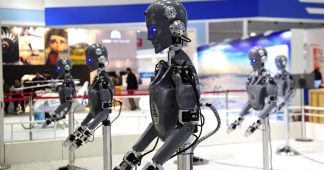One billion and 100 million jobs may be replaced in the global workforce by robots in less than a generation.
According to Mc Kinsey Global Institute’s Report, 49% of the working activities could already be automated by using current technologies.
It will be only a matter of time, a relatively short time.
That means that a billion and 100 million jobs may be replaced in the global workforce by robots in about a generation.
It is a terrifying prediction, considering the ongoing development of current technological capabilities.
That is, human labor will decrease year after year in various ways. In the Western world and in the Eastern world either.
It will have a far more dramatic impact on the Eastern world, though.
The same report – that is already causing a stir around the world – is adding that, among a lot of shocking predictions, out of 60% of all the current jobs created by modern people, about 30% of tasks done by humans could be automated, while given currently demonstrated technologies, 5% of other tasks are candidates for full automation.
On the other hand, Russian experts are engaged in researches that are achieving similar results. Even the most cautious among them – for example, Elena Larina, IT teacher – believe that over the next 20 years about 45% of the intellectual professions and about 75% of physical works could be substituted by robots with different automatic systems.
Therefore, next generations could really be witness of radical changes, both from the point of view of quantity and from a point of view of quality.
There will be a lot of workers in redundancy, because they won’t be necessary any more to the production of goods and services. Production will be able to carry on without them.
Those unemployed people will not remain in the areas of the planet they live in, they would rather move around.
They will move following paths which are different from the ones we are witnessing even now, in a new industrial revolution which has no numerical order yet: it is the third or perhaps the fourth and soon the fifth will arrive.
The current migrations will change completely and reversed.
This “reversal” is only beginning but – if these predictions won’t be upset by even more unpredictable events – it will lead to the end of the current shifting of production from the industrially advanced Western countries towards Asia, Africa and South America.
Already during the current times, Elena Larina is reporting, “Robots manufactured in USA and Japan, with an average of two years amortization, are already set in serial production. They are cheaper than Chinese or Indonesian labor.’’
The following figures are meaningful for everybody: only in 2015, more than six thousands USA companies came back from different Asian areas, where they had previously moved in order to reduce their costs.
Then we have another figure to add.
The effects of automation are already much more devastating in the less technologically developed countries and this situation is going to be even worse there over the next years.
The “liberation” imposed by technologies and applied to societies with a low productivity will increase more and more mass unemployment in certain countries, precisely those that, using a euphemism, we call “developing countries’’.
During the first decade of 21st century it was predicted that, during the following twenty years, Europe would need at last 20 million immigrants, in order to counterbalance the low birth rate characterizing all its countries.
Yet only ten years later it looks like those predictions have been swept away by compelling forces that had not been taken into account.
The big picture that is coming out seems more disquieting.
Europe won’t need this immigration that – it is understood – will grow in bigger numbers than today’s migration.
Furthermore, mass unemployment will extend to industrially developed countries too.
It is probable that we will have to make all the estimates all over again.











